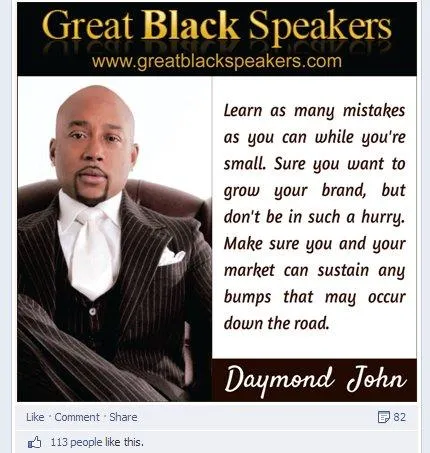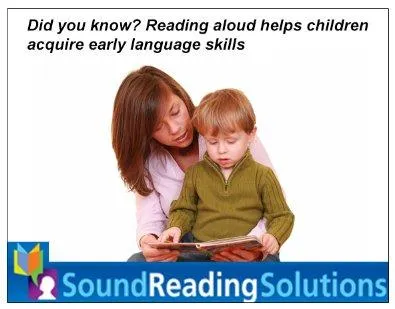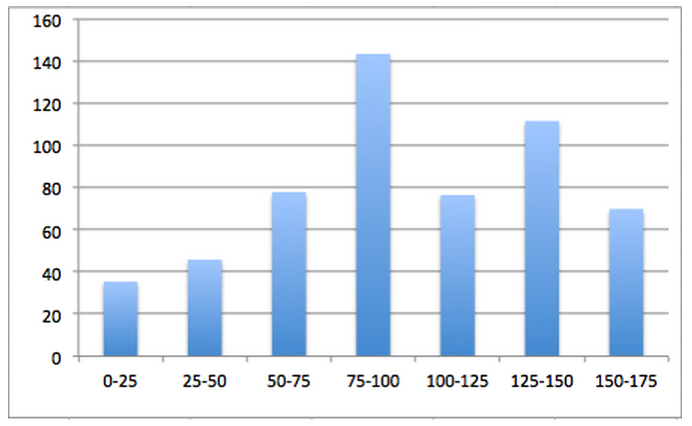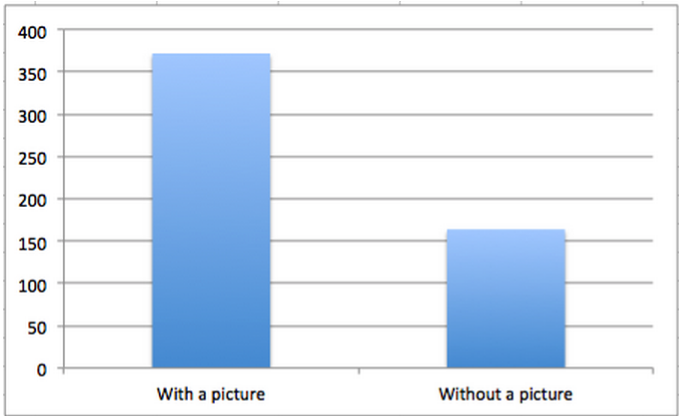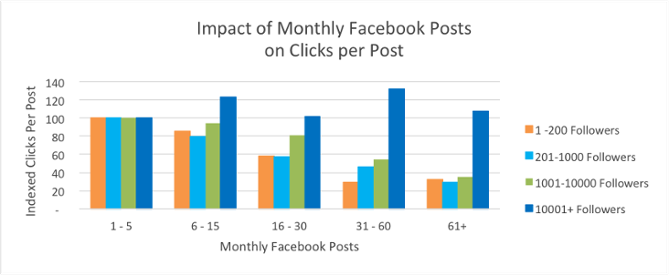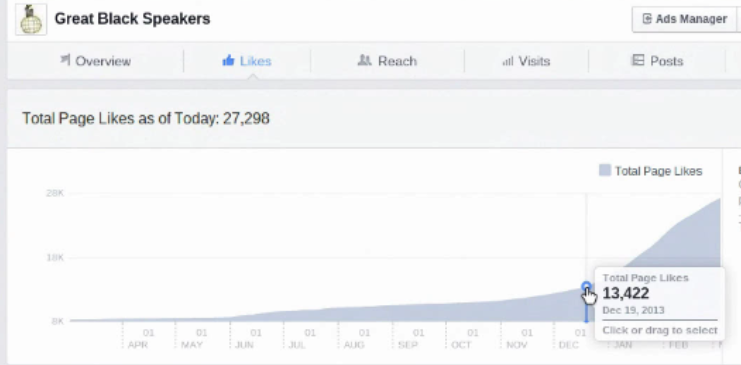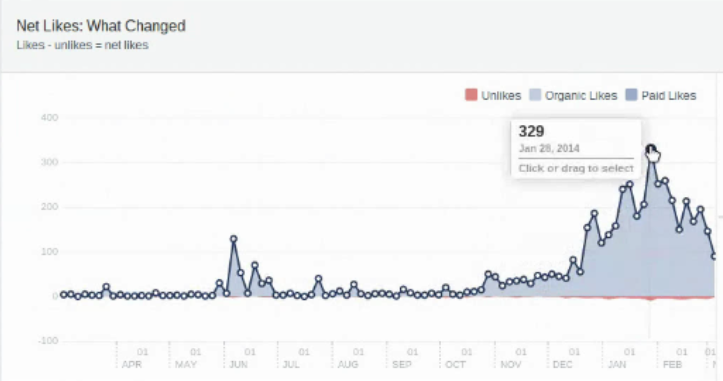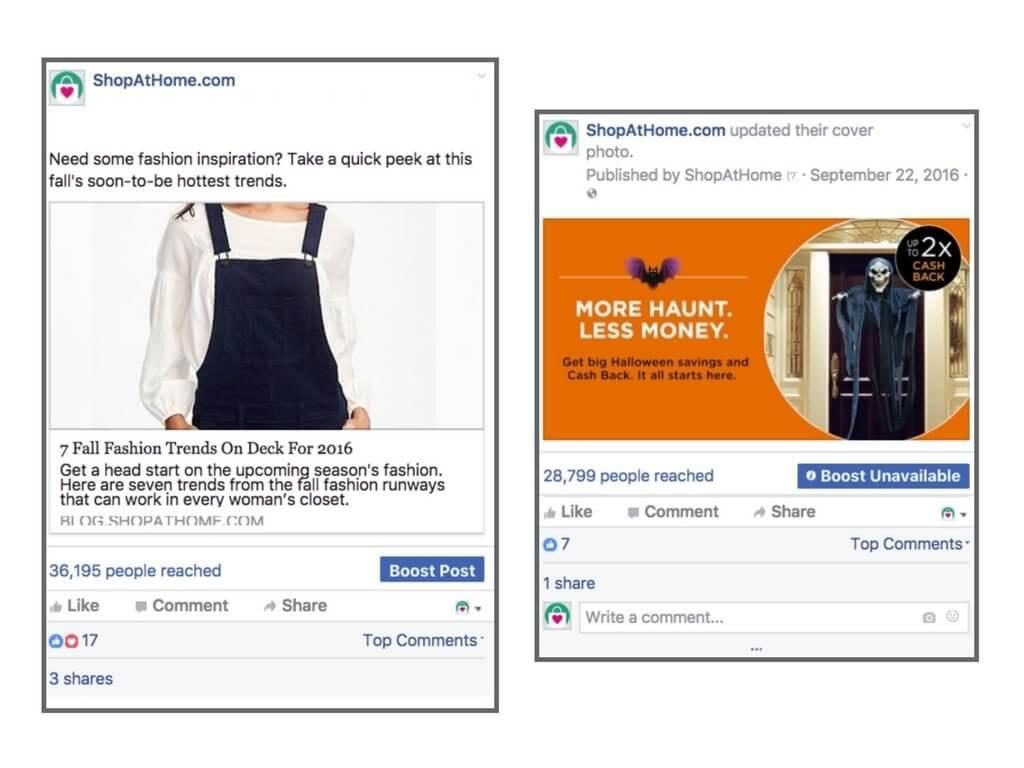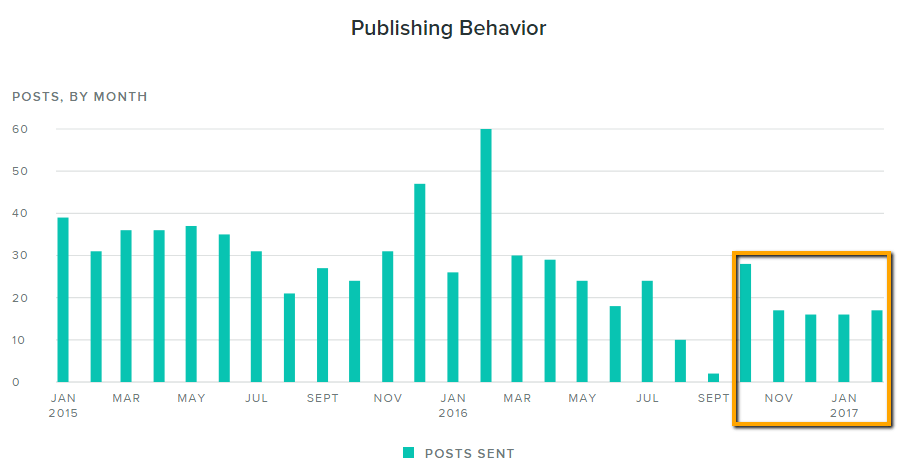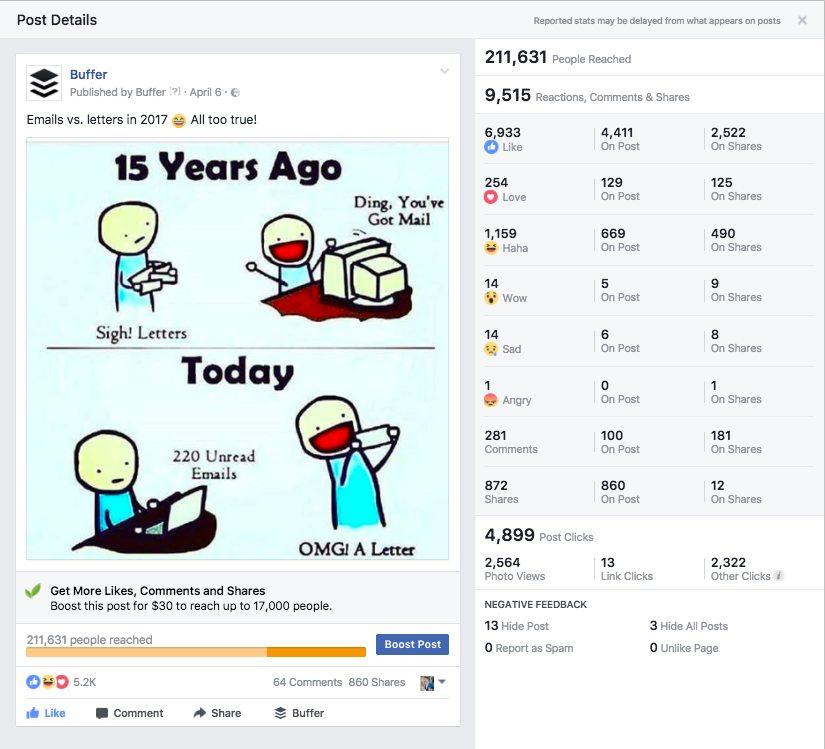How to Get 100,000+ Organic Facebook Likes Without Spending Money on Ads
I've always had a bias against social media.
Until a few years ago, I hadn't thought of it as a "real" marketing channel.
I'm now certainly convinced of the opposite.
Back in 2014, I contacted my friend Lawrence Watkins of Great Black Speakers because I was in awe of his success on Facebook.
Back then, he only had 30,000 page likes.
Now?
He has over 138,000.
If you’re interested in hearing about his Facebook page success, check out my interview with him from 2014 below.

I was blown away when Lawrence told me that he wasn't using advertising to get those likes.
Not only that, but his Facebook page was driving a growing amount of business via traffic and email subscribers.
But here’s the thing about using social media as a business owner— it’s a long-term game.
It requires constant engagement, and you may not see quick results from your efforts.
But sometimes, as you’ll find with my friend Lawrence above, the results are worth the long-term effort.
It turns out that the advice Lawrence taught me in 2014 is just as relevant today.
In this article, I’m going to teach you a few of the tactics I’ve learned from Lawrence on how to grow organic Facebook likes for your business page.
Hopefully, this will help you expand your reach, and ultimately help you win more leads and sales.
I’ll also cover:
- The benefits of having a Facebook page for your business.
- What types of businesses it works well for.
- How to grow your Facebook page likes organically.
- And—best of all—how to measure results so your effort isn’t wasted.
I have also thrown in a few bonus case studies for the types of Facebook posts and/or content that’s giving businesses real organic growth.
So if you have a Facebook page you’re looking to grow, get ready to take some notes.
Let’s dive in.
Should You Create a Facebook Page? Here Are Some Questions to Ask First
The first question any business should ask before investing resources into a Facebook Business Page is…
1. Can a Facebook page grow my business?
Without understanding if Facebook can grow your business, you’re wasting precious time. That makes this an important question to start with.
Here are the primary benefits of a Facebook Business Page:
- Traffic – Having a strong, engaged base of Facebook fans correlates with an increase in website traffic referrals from Facebook.
- Email list growth – Since marketing via your Facebook Business Page is best thought of as “demand generation” and not lead generation (since you’re not initially looking for a direct bottom-line response), it’s easy to funnel your fans from Facebook to landing page offers that result in more email signups.
- Leads – After you’ve established a Facebook fanbase via your page, you can post offers occasionally that will result in a direct response. These include purchases or a consultation request. That said, those direct offers will be less effective than indirect offers (such as offering a free e-course or downloadable report). That's because indirect offers give you a better opportunity to educate and warm up prospects.
Think about it like a step-based process.
You're moving people from lower levels of knowledge and engagement into higher and higher tiers until they become a customer.
- Sales – Sales are directly tied to the leads you produce. An increase in leads often means an increase in sales as well. For B2C companies where the purchase size is smaller than B2B companies, these companies can make sales offers directly to their Facebook fans.
In this scenario, a growing Facebook Business Page often correlates with a rise in sales. B2B companies can accomplish the same, but they need a longer-term approach.
So whether you’re a small business owner, a marketer, or a startup entrepreneur. Or you're wondering how to scale your digital marketing agency—any and all of the above results are desirable.
2. How do you know whether Facebook is the right marketing channel for you right now?
Any question about whether your target audience is on Facebook is relatively moot.
Just check out the graph below from TechCrunch.
TechCrunch states that there are over 2 billion active Facebook users and counting.
So as you decide if growing your Facebook page is the right marketing avenue for your business right now, ask yourself these additional questions:
- Can you think of content that is educational, inspiring, or entertaining while still related to your core business?
- Can you sustain an ongoing effort of regularly posting fresh, relevant content every week? Remember, content marketing quantity increases traffic.
- Do you need leads right now, or are you willing and able to invest for the long haul (plant seeds and harvest in the spring)?
- Is your brand offering something people can personally identify with? Is it related to who they are as individuals?
Let’s unpack each of these questions.
First, as you’ll see from watching the video interview with Lawrence, people on Facebook will interact most with content from pages that fall under one or more of these categories: educational, inspiring, or entertaining.
Why?
Think of it like this: Facebook is the new TV for many people.
These people are often taking a break from more productive activities while they browse Facebook.
In fact, they usually don’t have a specific goal in mind.
Second, it’s important to be honest with yourself when you ask the question: “Can I commit to implementing this strategy consistently for 6 months or more without deviating or getting distracted by some other marketing priority that pops up?”
Understand that most of the work required to grow your Facebook page includes regular research, content curation, and content creation.
The content you choose to share should strike a balance between being completely in the interest of fun and generating “good karma” within your target market.
This means the content is solely beneficial towards the end goal of growing your company.
Third, do you want results right now?
If you do, go spend your money on Google AdWords, sign up for email marketing software, or try other direct-response channels.
Facebook can work for just about any business, but it takes time to build an engaged community of fans.
Fourth, and this one is especially relevant to Facebook users…
Perry Marshall pointed this out in an interview from a few years ago. Google is about direct intent (“I want information on X right now”).
Facebook is about identity (“I’m sharing this blog post or liking this page because it reflects who I am as a person”).
In the case of Lawrence’s company Great Black Speakers, many people undoubtedly like the page because it expresses the inspirational ideas of black leaders and famous figures from African American history.
This is one unique aspect of the business.
As Lawrence points out in our interview, there is an emotional connection for his Facebook followers.
And the same can be said about buying an engagement ring.
This is why companies like Blue Nile are so successful on Facebook.
A challenge for Growbo (and maybe your business too) on Facebook is finding an angle that’s not just agreeable to your target audience (like famous quotes, for instance), but finding one that has some emotional root.
Again:
- People can deeply and emotionally identify with the Great Black Speakers brand because racial identity is physically part of who someone is.
- There’s a strong reaction to the engagement ring photo from Blue Nile because an engagement ring is a romantic symbol of lifelong love, family, and commitment.
3. Is Facebook page marketing better for a B2B or B2C company?
This is also a key question to consider when deciding whether to invest in a Facebook marketing strategy.
In my professional opinion, Facebook is better-suited for B2C companies than B2B companies.
Why?
Most people on Facebook are there just to “waste” time casually, as mentioned above.
They’re rarely thinking about making purchases like website design services, email marketing software, CRM software, or call center services.
But in 2015, The Drum wrote that Facebook played a role in consumers’ purchasing decisions, both on the Internet and offline, at a rate of 52%.
Just one year prior, in 2014, that number had been only 36%.
So Facebook can be a profitable marketing channel for almost any business, then.
The key takeaway here is that if you’re a B2B company, you need a longer-term approach to Facebook.
The content marketing strategy (as I’ll show you in this post) is done primarily in a B2C style.
Here are some tips on what to post and how often for both B2B and B2C companies.
For a local B2B call center service:
- Post funny cartoons and memes about bad customer service or something relatable about working in an office twice per week.
- Post a daily customer service tip with a photo of a professional, friendly-looking call center representative with your brand overlaid on top.
- Post about local news or events with a compelling photo once a week. Consider making these posts a question: “Have you checked out the local haunted house in downtown Houston yet?” This emphasizes and reminds people that you’re local to the area. You will also be positioned as a preferred provider.
For a B2C online reading software company:
- Once or twice a week, post positive statistics or researched facts about how improving reading ability and comprehension impacts a child later in life. Overlay this stat on top of an image (such as a teen graduating from high school) and include your logo in the corner. I included a simple example below to further illustrate this point.
- Post a testimonial from a satisfied customer twice per month. Because social proof sells. This should include an image and follow the above format.
- Post a daily reading tip that can help parents improve their child’s reading ability. This should again follow the above format.
How to Get Organic Facebook Likes
Get Organic Facebook Likes By Using Cross-Promotion
Cross-promotion is one way to kick off organic Facebook growth.
For instance, Lawrence and his brother operate a few joint ventures together that have similar target markets.
This has provided an initial advantage whereby these existing Facebook pages could be leveraged to drive likes for the Great Black Speakers page.
If you want to use cross-promotion like Lawrence did, here’s the best process to follow:
- Understand that if your goal is to leverage another brand’s marketing channel on Facebook, you have to come to them with something of value. What are your options? It can be a) money, b) exposure through your Facebook page or c) relevant content.
- For argument’s sake, let’s assume you don’t want to or can’t afford to pay. You also have too few followers for an offer of mutual promotion to be very valuable. In this case, you should create a lead magnet. And if you need some inspiration, there a plenty of examples of lead magnets. A highly-detailed guide, a checklist, or an eBook of some kind to give away for free. This goes back to the good karma mentioned above. You get plenty of exposure too.
- Make a spreadsheet in Excel or Google Docs of 50 to 100 Facebook pages in your niche (non-competitors, of course). Again, I suggest that number because it’s meant to “seed” your page with an initial batch of fans from your target demographic.
- Once you have this list of Facebook pages, create a short, 2-3 sentences message template to send to each of them. Make sure you’re logged in on your Facebook Business Page when you do this. That way, it’s easier for the recipient to check out your page. They can also copy and paste a direct link to your page onto their next Facebook post. This is what you want.
Try this sample template:
“Hey neighbor,
My name is [name] and I’m writing to you because I noticed [name of brand or company] has the same target audience as [name of your business or brand], which is my business. I recently created this [free guide/blog article] that I think your audience will love.
[title of guide/article]
[resource link]
Feel free to share it, and if you do, it would be awesome if you linked it to your Facebook page. Thanks, and looking forward to hearing from you.
[name]
PS – I’m sure you’re busy, so I took the liberty of writing up the text for the actual wall post for you. Feel free to tweak it as you see fit.
[insert question to get attention as a precursor to what value/answer they will receive as a direct result of clicking the upcoming link] – Learn the answer here: [resource link] (And check out [your page link’s] Facebook page if you’d like to see more content like this.
Of course, if you don't want to deal with digital marketing tasks like copywriting or design, then Growbo can do that for you.
We take care of all of your digital marketing tasks and projects while you focus on working on your business.
That being said, you’re now ready to start sending out messages to the list you compiled.
It's almost like when you create an email sales funnel!
A word of caution, though. You should throttle your message-sending to 15 to 20 messages a day. Otherwise, Facebook might temporarily block your messaging privileges.
One way around this is to put a little extra thought into customizing each message. The more you customize your messages, the less likely they are to be perceived as spam by Facebook.
You can expect an overall conversion rate of 7% to 15% with this tactic. The main factor (which you have complete control over) is how compelling the content is that you’re offering in return for the share.
Want to learn how to scale your digital marketing agency, eCommerce store, coaching service, SaaS or info product business? Then
Get Organic Facebook Likes By Posting Images
One word: pictures.
That was one of the big takeaways from my interview with Lawrence.
This idea is supported by research as well.
Quicksprout reports that Facebook users engage with posts with photos 39% more than those without.
Let’s back up a moment.
This begs the question: How is engagement defined and why is it important?
Sprout Social describes engagement as the following: Engagement rate is the percentage of people who saw a post that liked, shared, clicked or commented on it.
Engagement matters because each interaction with your content creates a marketing echo on Facebook.
Others can see this echo in their friend’s timelines or within their own newsfeed.
In other words, by interacting with your content on Facebook, people are only helping to spread it. It's like promoting your content.
Thus, more engagement = increased reach.
If you think about it on a spectrum, from the least valuable form of engagement to the most valuable, it goes like this: click, like, comment, share.
A share on Facebook has the highest value from a marketing standpoint because of the way it's prominently displayed in friends’ newsfeeds.
As proof of this, if you open your Facebook newsfeed, you’ll notice most of the posts streaming down your feed are explicit link-shares users have posted to their walls. They're not likes.
In addition, according to the Facebook Newsroom, Facebook has tweaked its algorithm to favor brighter color contrast, bigger link previews, updated and bigger share buttons, and circular profile pictures.
Not only that, but Facebook now has a “return to newsfeed” back button option.
This was done to “create a more consistent experience” for Facebook users.
The big picture idea here is that images are best understood as the marketing currency of Facebook.
This is further supported in my interview with Lawrence.
You can see in the video and on the Great Black Speakers Facebook page that many of their posts are imaged-based.
In fact, not only are the inspirational images on the Great Black Speakers page getting 10x the engagement, but they’re also massively shared.
Research from BuzzSumo states that you should sprinkle in images often, one image per 75 words you write! These articles are shared 30x more.
On Facebook, you can increase engagement by as much as 2.3x more through images.
Oh yeah, and you can also see a spike in Twitter retweets (by as high as 150%) with images as well, according to BuzzSumo.
Get Organic Facebook Likes By Increasing Engagement
You can also grow your page likes organically by increasing engagement.
The more your followers engage with your posts (by liking, commenting, and sharing), the more likely they are to end up in their friends’ newsfeeds because of the “marketing echo” we mentioned previously.
[Note: you’ll get the likes for free with these tactics, but you still have to earn them by making sure the content is relevant and interesting.]
Here’s the kind of content you want to focus on:
- Famous quotes as part of your branded image
- Pictures of people in your organization as well as company events
- Branded memes and entertaining cartoons
- Surveys, coupons, contests, sweepstakes, or raffles
- Videos
Contests, sweepstakes, and raffles in particular are an excellent way to grow your Facebook engagement and get more likes.
CMS company Kentico proves the importance of these special offers. They found that up to 39% of Facebook users surveyed will follow or like a brand for these offers.
I personally know about the importance of contests, sweepstakes, and raffles because I’m friendly with the founder of RaffleCopter.com.
The way that site works is you choose the type of raffle promotion you want to run and then determine how people can enter.
They may have to complete a survey, leave a comment on a blog or more.
Then you install the app on your Facebook Business Page (and website or blog as well, if you’d like). Finally, you’ll get tools to measure your raffle results in real-time.
Data from JSMM + VBM supports that coupons and quizzes are a great way to increase engagement. You could see a spike in your engagement rate as high as 12%.
Not only that but if a quiz appears on a friend’s newsfeed because you already took it, there’s an 82% chance they’ll take it, too.
Here are some other more granular ways to increase engagement according to a HubSpot infographic:
- Plan your posts at night, specifically between 10 p.m. and 11 p.m. Your interaction rate could increase by 88%.
- Ask a question at the end of your post for an interaction boost of 162% compared to posts without questions.
- Add a video to your Facebook posts to net at least 89.5 shares.
- Keep your message light and don’t exceed 200 characters. Your post may be more likely to get 238.75 more shares.
When it comes to which days of the week are best to post, different studies have reached different conclusions.
The most definitive one we’ve found is CoSchedule’s, which supports posting at the end of the week.
And when it comes to figuring out how many times you should post on your Facebook page to increase engagement, sometimes it depends on how many followers you have.
Take a look at the HubSpot graph below.
The data shows that sometimes posting less can increase engagement if you don’t have many followers.
Pages with less followers posting 1 to 5 times a month saw more engagement than when they posted 31 to 60 times a month.
In short, when you post more, you’ll only see more interaction if you have a lot of followers (10,000+ per the graph above), says HubSpot.
Because as I said above, content marketing quantity increases traffic.
So your post frequency depends on your follower count.
How to Measure Results
There are 3 ways I recommend tracking your Facebook marketing efforts:
Let’s discuss each of these further.
Google Analytics
Google Analytics is an obvious choice.
It's an affordable online marketing tool.
Under the “Audience” tab, you can drill down and discover the quantity of traffic that Facebook sends you over time.
Also, you can use this tool to set up “Goals,” which are a means of conversion tracking.
These Goals can be used to track when your audience reaches a specific page, such as a checkout or post-purchase thank-you page.
Then, using “Goal Flow” under the “Conversions” tab, you can see which segment of your Facebook traffic is converting.
As an aside, it’s a good rule of thumb to try to convert your Facebook traffic into email subscribers first, then incentivize them to purchase from you.
According to Campaign Monitor, email marketing has a conversion rate that’s 40x higher than social media.
Facebook Edgerank Checker
EdgeRank determines where your post or story will show up on the newsfeed of your average Facebook user.
Understanding this algorithm is important because the higher your EdgeRank, the more likely your posts will appear higher up on a Facebook user’s newsfeed.
If you want to use a third-party tool, Socialbakers, once known as EdgeRank Checker, is also useful. Socialbakers makes recommendations on how often you should post.
The tool also suggests the best times to post (which are tailored specifically to your page based on your most recent engagement data) and which types of posts get the highest engagement.
Facebook Audience Insights
Lastly, you should use Facebook’s built-in analytics feature called Audience Insights.
Below, I included a screenshot from my video interview with Lawrence.
He used Facebook Audience Insights to go back in time (so to speak) and observe the inflection point where growth started to take off for Great Black Speakers (December 2013).
You can easily conclude what’s working best to generate growth for your brand by using Audience Insights as well.
For instance, for a while, Lawrence used Facebook Ads to grow his Facebook audience.
Surprisingly, it was when he and his team pulled the ads that growth occurred.
Of course, Lawrence also changed tactics, focusing more on posting quality content on a regular basis, including the aforementioned pictures of speakers and branded inspirational quotes.
The key metrics you want to pay attention to on Audience Insights are net organic likes per day and overall engagement rates under the “Likes, Shares, and Comments” graph.
Case Studies
ShopAtHome Changes Posting Style and Frequency for More Organic Likes
Online shopping site ShopAtHome provides coupons, discounts and cashback to those who use its services.
They hired SEO agency Volume Nine to generate more brand awareness on Facebook.
Volume Nine first took a thorough look at ShopAtHome’s current Facebook content strategy.
They discovered that ShopAtHome lacked reach (0.6% of Facebook followers saw their posts) and engagement (with about 10 reactions per post despite having more than five million followers).
Not only that, but ShopAtHome wasn’t sharing blog posts, focusing instead on posting news about deals and discounts.
Volume Nine soon began boosting some posts to reach more Facebook users.
After that, Volume Nine lessened ShopAtHome’s posting rate. Organic engagement spiked with this change.
The nature of the content posted was also different. Their content was now branded. It was also intended to educate and entertain ShopAtHome’s audience. See the example below.
ShopAtHome had significant results.
Their 3 most popular posts had a reach of 822,508 people. Organic Facebook impressions jumped by 150%.
Craig & Sons Termite & Pest Control, Inc. Uses SEO Tactics to Build Facebook Engagement With No Promoted Content
Redlands, California’s Craig & Sons Termite & Pest Control, Inc. is a bug removal company that had already tried to build Facebook engagement. They turned to Arkside Marketing for their second attempt.
Like the case study above, Arkside began by reviewing Craig & Sons’ posting schedule, audience reach, SEO performance, and audience engagement. The pest control company seemingly had no concrete posting schedule. Engagement was also down.
Arkside next determined that those who were 35 miles from Redlands and at least 35 or older were the target audience for Craig & Sons. Their audience was also made up of property managers or homeowners.
Besides just improving their Facebook page, Arkside also expanded the pest control company’s social media presence to Pinterest, Instagram, Google+, and Twitter. On Facebook, Arkside rewrote the Craig & Sons’ bio with high-performing keywords.
Although no one usually wants to see pictures of bugs, Arkside used that as an advantage. The images Craigs & Sons posted were intentionally unsettling. Not only that, but these images were educational and taught followers how to avoid insects and critters.
Other changes Arkside set into motion included:
- Adding more video to posts (but never breaking the 80/20 Rule)
- Creating SEO value in posts and social profiles
- Developing a consistent posting schedule (which was up to two posts daily)
At the beginning of the project, Craig & Sons had about 300 Facebook followers. As of this writing, it’s at about 500. Through organic content, Arkside hasn’t had to promote or pay for a single post.
Buffer Achieves More Engagement and Reach (3x Higher) by Changing Its Posting Strategy
You already know and may even use Buffer, a social media management service. Late last year, they decided their posting strategy on Facebook needed retooling. This was in response to brand advertising and updated social media algorithms.
To grow their engagement and organic reach, Buffer—like a few other companies in these case studies—also posted less, 50% less, in fact.
By cutting back on posts, Buffer reported 1,000 engagements each day (up from 500), and a bigger weekly reach of 150,000 Facebook users (up from 44,000).
How did they do it? And why?
The graph above shows Buffer’s average Facebook posts per day from January 2016 to April 2017.
Buffer recognized that their frequent posting was actually hurting their engagement rate. This could have been a case of their users simply being overwhelmed with too much content.
Regardless, here’s an overview of Buffer’s engagement after making the switch:
They also realized that posting just to post doesn’t fly on Facebook. Buffer notes that “not every post is right for Facebook.”
With so many social media platforms out there, sometimes it’s best to post on another one instead.
Today, Buffer mostly makes posts that are “edu-tainment”-focused. The word is a combination of educational and entertaining, such as this one:
This post was pivotal for Buffer, netting them 1,000+ new Facebook followers, 872 shares, 281 comments, 8,362 likes, and a reach of 211,631 users.
Wishpond Achieves Huge Organic Reach Through Facebook Live Video
Like Buffer above, Wishpond is another major marketing company dealing with a sagging organic reach on Facebook. Despite the name recognition, their 23,000 fans were barely responding.
In fact, only roughly 400 of them would react to a Wishpond post.
Instead of changing their posting schedule or the content they shared, they did something different. Wishpond turned its attention to the somewhat new Facebook Live Video.
This technology lets you film yourself for all your followers to see in real-time. This is still underutilized technology for businesses, so Wishpond was thinking smart.
Other benefits of Facebook Live Video? Those who watch can click “Live Subscribe” so they can always check out your upcoming live feeds. Also, these posts tend to float to the top of newsfeeds, so they’re very hard to miss.
Two staff members at Wishpond decided on a whiteboard presentation for their first Facebook Live Video.
During the video, they got detailed analytics about who was watching and for how long.
Their organic reach was also way up.
In fact, the video had a 300% spike in engagement, proving Facebook Live Video is another viable engagement option.
Conclusion
Want to learn how to scale your digital marketing agency, eCommerce store, coaching service, SaaS or info product business? Then
Facebook likes are a major goal for any business.
And as I’ve proved, you don’t always have to pay to get these likes.
That said, jumping into creating your own Facebook page shouldn’t be your first step after reading this article.
You’ll want to make sure that focusing on Facebook is the best choice for you based on your current business needs.
After all, building a large fanbase with a high level of engagement takes time.
But if you do decide that Facebook is a marketing channel you want to develop for your brand, here are some key points to keep in mind:
- Seed your initial growth by inviting friends and/or reaching out to fellow page owners and giving them an incentive to promote you.
- Facebook Ads are NOT a requirement to be successful on this social media platform.
- Think of images such as memes, photos of people or cartoons as the primary marketing currency of Facebook. Engagement rates are often much higher when these images are included compared to posts without images.
- There are other tactics to consider as well for increasing Facebook engagement—such as coupons, raffles and sweepstakes.
- When creating a posting frequency strategy for your business, consider the amount of followers you have. Test out engagement levels after posting 1-5 times a month for smaller follower counts, and 5+ times per month as you grow.
And if you don't want to deal with the stress of Facebook or handle any digital marketing task, then Growbo is the solution.
We take all of your digital marketing tasks off your plate so you can focus on growing your business.
Want an email sequence written? A long-form landing page design? A Facebook Ad campaign?
We do all that for you.
Now tell me something, are you planning to develop a stronger Facebook presence after reading this article?
If you already have a robust Facebook page, which tactics are producing the best engagement results for you?
Let me know in the comments.
Keep Growin’, stay focused,




